| "In the end, a mask reveals more than a face." |
| Germain-Roland Desmot (Antoine de Caunes) |
Sometimes what separates a very good, or even excellent album from being a truly great one, isn't the quality of the songs or that the album is front to back, all killer no filler. A theme, or (whisper it) a concept, is going to help give an album a cohesive identity and character that has something to say to the listener, helping them to bring the music into their lives on a much more personal level by readily identifying with it (or not). Thematic grouping and careful selection of track order can make that record something which only gives the listener its full impact when experienced as a unified whole. About so much more than just quick-fix singles, such albums allow the experience to move beyond simple entertainment into revealing discussions of the artists themselves and their intentions behind the music. You wouldn't skip a scene in a film, or a chapter in a book, so a truly great album must be the sum of all its parts. Not a collection of singles and slap-dash album tracks; it must be a body of work, a common narrative. Track sequencing is more often than not, the most vital ingredient in getting this right.
For the generation of us musically defined by mixtapes, where every choice is essential and time consumingly involved – a polar opposite mindset to the frivolity of thirty-second-judgement-call, instantaneous digital downloading – this is a(n all) too familiar pub discussion or late night raging debate that shapes much of how we assimilate and assess music. Rating albums and individual tracks by what precedes and follows them, not simply for rank, but as a way of helping us place and understand phases of a career within an entire body of work often spanning lifetimes and thus deciding in our own minds, the canonical texts of an artist.
For the cinephile, there is a natural commonality in this mindset when viewing the output of a director as prolific as Claude Chabrol. This body of work does indeed span a lifetime, 1956 to the present as a writer/director, with his latest, Bellamy, still awaiting a nationwide UK release following its inclusion in the 2009 London Film Festival.
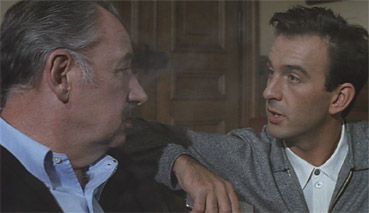
Artificial Eye, in helping the diligent film nerd plug some more gaps in a seventy-one-titles-strong filmography, gives us three more titles previously unavailable in the UK.
Whereas the previous box set featured a detective story and two portraits of women raging against what's expected of them, volume two does the reverse, offering two small community detective films and a third of a woman dangerously pushing the limits of what she can get away with to breaking point.
It's telling that when I reviewed the first box set, I lumped the women's stories together as a separate review from the detective film, subconsciously irked that that the three films when watched back to back did not hang together. This time I was certainly aware while watching them, that the grim seriousness of A Story of Women had no place besides the pair of subdued whodunits that preceded it. A Story of Women would have been far better suited and rendered more poignant, if it had been included in the first volume alongside Betty and Merci Pour le Chocolat, not least because as the third film, A Story of Women's pairing of Marie Trintignant and Isabelle Huppert would have been hotly anticipated after watching each respective actress ignite the screen as the lead in a film of their own. The prospect of then seeing the two powerhouses together at the end of a triple bill, would have made an otherwise grueling film that much easier to digest.
Like any great album or mixtape, Artificial Eye should have opted for thematic links with these volumes over easy, yet incongruous variety. The first volume, a trilogy of films about oppressed women and the extreme measures they take to beat their circumstances and the second, a triumtive of bourgeois rot under the magnifying glass.
As it is, this second volume in what I can only hope will be a continuing series, was without doubt, blow-for-blow, the weaker of the two. However, the set did force me to think long and hard as to the oft applied, reductive categorization of Chabrol's work. If these films weren't half as rewarding as the first three, they were almost as intellectually stimulating.
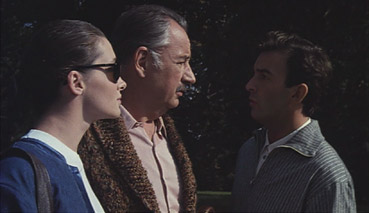
Far too often, Chabrol's preoccupations are surmised as "exposing the evil that lurks in the everyday". Doubtless this is part of his intention, but I'm now beginning to see that he values character over society and that he is less and less interested with the genres in which his films take place. In the instance of a detective film like Masks, the emphasis is far less on the third act expose of evil, as it is with posing the question of why such evil exists.
On the surface, we have a rather conventional detective story, in which Roland (Robin Renucci) investigates his sister's mysterious disappearance from the country home of game show host, Christian Legagneur (Philippe Noiret). Posing as an ego-massaging journalist, writing the now all-too-common, quickly trotted out biography for the most undeserving of "celebrities", he unveils Legagneur's sinister fraud of his god daughter Catherine (Anne Brochet), held captive in the house under false pretext. Is it she who can reveal the truth about the disappearance of Roland's sister?
The intriguing but nevertheless conventional set-up is there to be just that. It's as if Chabrol sets up such a framework only so he can point out exactly what his audience isn't going to get. In The Colour of Lies, a character plainly states that "in the end, a mask reveals more than a face". This quote headed the review, as it seems to speak directly to Chabrol's dominant concern across the three films once he has dispensed with the shackles of genre. Mystery and enigma will not be found in the maguffin-like plot machinations but the characters that drive them.
Noiret's game show host plays at Cilla Black for old folks, elatedly gushing at bringing two people together so helplessly late in life, in a way that makes him immediately suspect. His disingenuous praise of contestants when they croon the standards of their day in croaking, tired voice is contemptuous and mockingly condescending. The setting, while just as tackily eighties as Blind Date, is disturbingly modern in its foreshadowing of the now accepted and ubiquitous "hate TV" phenomenon, in which audiences would sooner ridicule contestants from their couch than cheer them on. Everyone, not just the audience, but the people who host and run these shows are laughing at the people up on stage, rather than with them and we see this attitude in its infancy in the film's opening scene. For those viewers who are later shocked by the morally vacuous and predatory personality Legagneur is betrayed to be when his mask slips in an unexpected moment of phobic terror towards an un-caged animal, I ask, "How could you be so blind?" It's all there from the moment we meet him and every time thereafter that the studio cameras are turned on him. Legagneur even delights in watching old tapes of his shows with his would-be biographer, all too clearly rubbing it in our faces whilst licking the insides of our ears with his silver forked tongue.
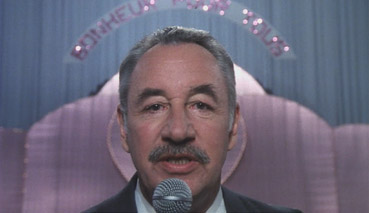
Philippe Noiret's portrayal is of such overblown brilliance as to suggest the similarly disgraced real-life game show host, Michael Barrymore. Watching youtube clips of Barrymore's weekly shows in the eighties, with humour as honest and funny as forced laughter in a telephone conversation, it's apparent that his real skill as a presenter was how he was able to pull the wool over a nation's eyes, all the while refusing to hide his true character. Watching him today, it beggars belief that no-one back then thought to question his sexuality or saw the pain behind every woeful bad pun even when both were clearly on display every Saturday night.
The mask then, is that which reveals more than the face wearing it, for wearing a mask is the barefaced admittance of the pain behind it. The mask is the wearer's cry for help that someone acknowledge the pain it is supposed to hide. When we are first introduced to Legagneur's god daughter, Catherine, wearing dark sunglasses over bee-stung lips, it's all to easy to read her as a prototype Emmanuelle Béart, yet Anne Brochet is able to unsettle as much as she beguiles, wordlessly communicating to Roland that he is the one she's been waiting for to divulge the secrets hidden behind her shades. Indeed, when we finally see them, her eyes are orbs of pain, regret and now, confusion. So long has she gone without a friendly ear that she is no longer able to disassociate her condition from her character or begin to objectively understand it. Catherine's inner torment and uncertainty about herself is puppeteered by Legagneur, who asserts that "women are like toys" in a game where the object is not winning but not allowing your mask to slip until the person/people looking at you finally see through it on their own. On this, Legagneur prides all things, equating the understanding of truth with loving your work passionately, the work itself being its own religion. The game show host has devoted his life to this work of thinly veiling the truth and his derision of those who watch him is because no-one is as brilliant as he and able to see through his mask. Legagneur tells Roland that a "metaphor is the best way of expressing an idea... if you can decipher them. If not, they are just images, which isn't half bad". The mask is the metaphor through which he expresses the idea of himself, and in the end, he tells his audience to "Get fucked" when he finally comes to the realization that they'll never decipher it.
If we, the audience at home, cotton on to the fact that Legagneur is the "bad guy" a long time before the third act final show, it's because it's entirely by design. Directorally, Chabrol takes off his mask a long time before he allows his character to do so, if only to afford Legagneur the opportunity to be acknowledged and understood by an audience in a way his fictional TV viewers are(n't) able to.

I'm not sure what can be made of that fact that, twelve years later, The Colour of Lies, has Antoine de Caunes' smarmy, cocksure television journalist as the ostensible antagonist, but I can tell you that this largely non dramatic mystery is populated with faces that are very open and completely unknowable at the same time. Masks become indistinguishable from real faces and it's hard to know at any one time who is wearing what or if there is any real difference between the two. It begins with art teacher René (Jacques Gamblin) and his young student painting. The child in full colour, the adult in shades of grey, positioning the two worlds they inhabit and alerting us to the irony of the title.
The child is murdered after leaving her lesson, and René becomes the chief suspect. Rumours then start circulating the small town where he resides, having ruinous effects for him professionally and exerting massive strain on his marriage to Sandrine Bonnaire‘s Vivianne. Gamblin's performance though clearly committed, comes without a road map for both the actor and the viewer. While able to convey in no time at all the traumatic effects of the sudden loss and having accusatory fingers pointed at him, there is never any definite sense of how exactly he's been affected and what he's feeling in any given scene. His eyes are haggard and haunted but you can only guess at what's keeping him up at night. The lack of psychological insight is unforgivable for a film that wants to be character study first, crime mystery second. Sandrine Bonnaire visibly struggles in her scenes together with Gamblin, the actress unable to get a handle on her screen partner in the same way her character is unable to see through her husband's mask of withdrawal so that she might communicate. René hides behind his mask of near-catatonias to protect himself, but from what we're not sure, other than the general sense that the murder has occasioned unwanted ripple effects into all corners of his life, calling the truth of it all into question. Despite this, both performances keep you gripped, husband and wife drifting further and further apart with the growing sense that each never knew the other as well as they assumed they did. As the characters drift, so to do the actors, and despite their best efforts with vague material, they're unable to dig deep enough for a connection or quiet epiphany promised by the title.

In almost every scene, there is the hope that Chabrol is so many steps ahead of his audience that he can be depended upon to bring it all together in satisfactorily shocking fashion with a dénouement that could never have been guessed at. As is Chabrol's custom, the crime thriller mechanics are but an entry point for an examination of some greater human (un)truth, but here the narrative "dressing up" really fails him, getting in the way of and deflating the character scenes. The film is never able to achieve that "second level" of incisive commentary you expect with a Chabrol mystery and as it limps towards a conclusion that feels more like an off-the-cuff prank on the viewer, you feel thoroughly cheated given all the initial intrigue squandered. Strands are clumsily brought together, so as to strain suspension of disbelief beyond all credibility, and with an ending worthy of only a shoulder shrug in terms of it's fumbled execution, there is an instant need to re-watch the final twenty minutes to ensure something essential wasn't missed. Abruptly cutting to the credits, it feels as if scenes are missing in the final minutes and with the last proverbial reel change, it's as if there was a sudden tonal shift Chabrol forgot to warn us about, cheapened further by peripheral characters taking center stage without having earned the right. The twee wrap-up is a real sucker punch that prevents The Colour of Lies from crossing the finish line by hooking us with its effecting tone of marital discord till the end.
While Chabrol ought to be celebrated for not meeting the expectations of genre and convention, so as to lay bare the uncertainties of reality, the reality presented here is in no way recognizable. The best fiction tells lies in order to reveal deeper truths and in this instance, no matter how many lies Chabrol's characters tell through a smokescreen of art and media, the truth barely runs as deep as the surface of things.
A Story of Women is the jarring departure from psychological crime thrillers that rounds out the set. The story of illegal abortionist Maire, who for her crimes, was the last person to be executed in Nazi-occupied France, this isn't half as heavy as it sounds, if only because it comes without the sentimentalism and sympathy from the director's chair that undermined the similarly themed, Vera Drake. There's no obvious Oscar-baiting, grandstanding in this film which suffers from the exact opposite of the Mike Leigh film, in that it's probably far too even handed for most. Isabelle Huppert and Claude Chabrol never so much as bat an eyelid at Marie's shady operations, and as a result neither do we. So nonchalant is the adulterous Marie in doing whatever she can to provide a better quality of life during wartime for her children, that when Marie Trintignant's prostitute becomes a friend and tenant under her roof, it's played off as the logical and understandable extension of Marie's enterprising vision of a better life.
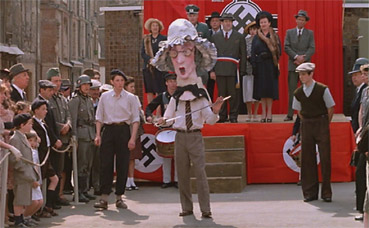
A character like this would ordinarily be expected to be acting on the compulsion to help those many women baring the bastard children of the occupiers while their husbands are away on the front lines. Maire as it turns out is only after a bit of the good life in hard times for her and the children. Facing execution for her services, she calls out the all-male courtroom, "It's all men. How could men understand?" Her words point to the hypocrisy of the system and her country, not some unjustly misunderstood humanitarian motivation. Marie's actions are borne out a purely fiscal impulse where a distant and unloving marriage can't suffice. Like the child living in the fairy tale Holocaust of Roberto Benigni's Life is Beautiful, Marie needs the fantasy of upward mobility to somehow make the war more bearable – she even goes so far as embarking on an affair with a suave, high-ranking Nazi sympathizer, treating her and the kids to Sunday coffees and ice-creams, and on such days it's as if the war around them isn't really happening at all. For her spiraling degree of delusion, Chabrol never condemns Marie, nor is he tempted to use her as the fulcrum for an easy morality tale. Once she begins openly cheating on her husband and shamelessly attempting to set him up with the maid (less to avoid guilt than to sidestep the fierce rows her infidelity causes, which distract her from her goals), the rest of the film's running time is a clock ticking down on how far she can go and how much she can get away with before the guillotine must inevitably fall.
Huppert's icily prim and proper housewife is not a character whose barriers gradually erode in an arc of extreme circumstances as lessons are learned, rather she comes to the drip-feed recognition that there must be more to life than this. Considering all the life she's already wasted, it's only natural to adopt the laissez-faire attitudes of her business associate and lover who still have so much to live for. She might share her house with a prostitute, but looking back, who's to say this is anymore wrong than the mistake of her life she's made thus far? Especially given that her country has already made so many mistakes that she spends her days correcting.
Huppert expresses all this without speeches or "big moments" of sub textual catharsis, in fact she hardly seems to say a word that isn't betraying the barely contained thrill of the pursuit of more money. The haughty wardrobe remains the same, but the more time she spends with Lucie, the more her eyes and body become uncomfortable in the clothes, at first vicariously coveting a lifestyle she thinks it's too late to have until one of Lucie's clients expresses interest. So withheld is she in speech and dress, you find yourself watching carefully for every facial ripple and bodily buckle in her outward presentation signifying an inner transformation that only reveals itself when she's berating her husband, a just as subtle, put-upon François Cluzet, who would later assume leading man status in Chabrol's L'enfer and more recently, French box office sensation, Tell No One.

Reduced to spending his afternoons making newspaper collages after losing his job, as a disgraced father and husband who can't provide in any of the ways he should be, Cluzet cuts a pitiful, tragic figure still reeling from his country's defeat. It is the women once again as in the first volume, who are unrepentant to the end and resist their circumstance as unknowing feminists.
While the fireworks don't fly in the way I was hoping between Huppert and Trintignant after their jaw-dropping displays of the first volume, this clearly is not the film for that. These are performances of barely noticeable modulation, which despite the title's melodramatic potential, never once risk gaudy caricature. Both actresses refuse to let their character's occupations define or guide their roles, presented here as a product of the circumstances that define a friendship based on common understanding. Marie's range of masks she wears, depending on her company, is what keeps you glued when lack of any foreseeable arc or narrative thrust doesn't. Huppert's performance registers in an astounding range of keys; astute and calculating when conducting business, just as undaunted and skillful when performing her illegal operations, yet somehow loving and completely relatable as a mother. The unloving and abhorrent wife is the very same mistress who is reckless and care-free, all traits which lead to her eventual execution but for which she never apologizes.
Chabrol's level of detachment results in a film almost impossible to ever really engage with, but Huppert, hypnotic cipher as always, never ceases to amaze. This earlier film could in fact be included in a very different collection altogether, alongside more recent entries like Gabrielle, and Private Property where her performance is of so much more worth than the films that feature them.
The Colour of Lies and The Story of Women have been sourced from Mk2 in France – both are framed 1.66:1 anamorphic, are clean of dust spots, have a reasonable level of detail and a pleasing, non-aggresive contrast range. The pastel colour palette of the former and the earthier, period-look hues of the latter are cleanly captured. The Colour of Lies does look a tad edge enhanced, with halos visible when characters are framed against light coloured backgrounds, and the black levels grey out a little in darker scenes, but not excessively so. The Story of Women is the stronger of the two, with no obvious signs of enhancement, more consistent contrast and punchy reproduction of brighter colours when they do intermittently appear. Masks doesn't fare so well, having a far more variable contrast range, washed-out colours and picture that at times looks downright flat. Shadow detail in places is poor. The framing here is an unlikely 1.73:1 and the picture is anamorphically enhanced.
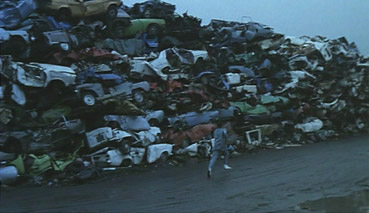
All three films have Dolby 2.0 mono soundtracks, but as with the picture there is some variance in quality, with the Mk2 transfers coming off best, both being clear, problem-free and boasting solid reproduction of music, dialogue and sound effects (the rumble of a storm in The Colour of Lies is particularly good). It's a very different story with Masks, whose audio range restriction issues are made worse by variable sound levels, distortion on loud effects (it really gets bad at the start of chapter 11) and a peculiar but quite pronounced reverb on much of the dialogue and background sound. Music reproduction is also on the rough side. Not a good one.
If Artificial Eye are going to continue to put out volumes of Chabrol's work, is it too much to ask for features which might lift the lid on the man behind the camera or delve into his working methods? Considering how many films he has under his belt, it's surprising how little has been written on his work when you compare him with his peers. Surely by this point, he's worthy of one or two commentaries from learned film historians? For now we'll have to make do with trailers for the films distributed by Artificial Eye.
That Artificial Eye has blessed us with these releases is to be forever in their debt, but when packaging them together in this fashion, more thought needs to go into how the films are selected. Collectively these sets are a bumpy ride that lessens the power and enjoyment of the individual films, as well as the relevance of their release. Here's to volume three being less of a grab-bag and of the same quality of the first set, which isn't the case here. For the completist however, essential is still the appropriate adjective.
|